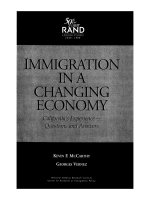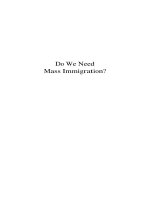19374 immigration
Bạn đang xem bản rút gọn của tài liệu. Xem và tải ngay bản đầy đủ của tài liệu tại đây (91.05 KB, 2 trang )
For a chance at a better life, it helps to
make your bad story worse.
by Suketu Mehta August 1, 2011
ABSTRACT: ANNALS OF IMMIGRATION about asylumseekers embellishing their stories. The writer met Caroline one
Friday evening in the cafeteria of the upscale Manhattan
supermarket where she worked. She was a twenty-something African immigrant
without papers who was living three lives: as Cecile Diop, a woman with papers
who had been in the country for ten years; as Caroline the African rape and torture
victim; and as herself, a middle-class young woman who wanted to make a life in
America. (Names and other identifying details have been changed throughout.)
Diop, a fellow expat from central Africa, had lent Caroline her Social Security
number so that she could get the job. Caroline was expecting her first paycheck,
which she would give to Cecile to cash. “Some of them take half,” Caroline said,
about such arrangements between immigrants.
Caroline had come to the U.S. the previous summer for a family wedding.
When her parents left, she stayed, even after her tourist visa expired. Now she was
working on a story—a four-page document that she would give to the lawyer she
had hired, and to immigration officials—saying that she was beaten and raped more
than once by government soldiers in her country. “I have never been raped,” she
admitted. It’s not enough for asylum applicants to say that they were threatened, or
even beaten. They have to furnish horror stories. Inevitably, these atrocity stories
are inflated, as new applicants for asylum get more inventive about what was done
to them. Caroline’s parents are supporters of a controversial opposition leader, and
government soldiers ransacked their house twice. Although they didn’t rape her or
her sisters, they beat her brother.
To buttress her asylum claims, Caroline has to obtain a letter from a hospital
stating that she had been treated for torture. Describes her therapy sessions.
Caroline was getting help in crafting her narrative from a Rwandan man the writer
calls Laurent, who was a sort of asylum-story shaper among Central Africans. The
writer accompanied Caroline to the immigration office where she made her case for
asylum. Describes her interview with the immigration official, Novick. He wanted
specifics about her rape and mistreatment back home. Last year, about fifty
thousand people applied for asylum here. Less than five per cent came from central
Africa. In all, 21,113 applicants were given asylum. The majority of asylum seekers
in America, immigration experts say, really would be at serious risk if they were
returned to their countries. Caroline does indeed have a “well-founded fear of
persecution” if she returns, but she felt that she had to augment the story with a
rape because
immigration
system
can better
A –the
ANSWER
THESE
QUESTIONS
ONcomprehend
THE TEXT: such a story. A couple
of weeks later, Caroline returned to the asylum office and was told that her
application had been approved.
Who did the writer meet?
Where was the girl from?
How many identities
did she have?
/>Who lent her a social security number? Why?
What was she waiting for?
How many people applied for asylum last year?
B – COMPLETE THESE SENTENCES ACCORDING TO THE TEXT:
Despite having a tourist visa, Caroline decided to
________________________________________________
She is working on a written document explaining that
____________________________________________
She is going to lie on her report because
______________________________________________________
She needs a letter from the hospital in order to
________________________________________________
According to official experts most immigrants would be in danger if
_______________________________
Fortunately her story was accepted ans she is able
_________________________________________ in America.
C- WHAT /WHO DO THE UNDERLIED WORDS REFER TO?
Where _____________________
Who _______________________
Which _____________________
These ____________________
Where ____________________
They ______________________









